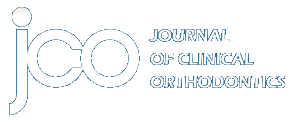In this issue, we conclude our three-part presentation of the 2008 JCO Study of Orthodontic Diagnosis and Treatment Procedures. Along with Parts 1 and 2, which appeared in the November and December issues, this segment confirms the impressions that many of us have had over the past few years about the direction in which the practice of clinical orthodontics is going. There are a few, but not many, surprises.
One point that stood out to me in the area of diagnosis and treatment planning is the finding that fewer routine diagnostic records are being taken. As recently as 10 years ago, the status quo with respect to pretreatment diagnostic records was panoramic and cephalometric radiographs, facial and intraoral photographs, and study models. Few orthodontists now take that full battery, with the panorex now the only record obtained in the vast majority of cases. Digital imaging and computerized analysis are taking over--film cameras having virtually disappeared--but in general, we are noticing a trend toward fewer pre- and post-treatment diagnostic records. This could have a far-reaching impact on what is considered the "usual and customary" standard of care and, consequently, what records are required for board certification and publication.
On the treatment side, we found that esthetic brackets and titanium-alloy archwires are continuing to gain in popularity. Stainless steel has served the specialty well for three generations, but newer materials that are both more patient-friendly and more doctor-friendly are slowly but surely replacing the old workhorse. If and when stainless steel goes into retirement, it will be in good company, joining gold and silver as materials that served their purpose well in their day. Bands also appear to be on the way out; given the further changes in orthodontic procedures noted in the Study, perhaps the only remaining need for bands is for the application of headgear to the upper arch--and that treatment modality is also declining dramatically. As for bonding, the two-paste, pad-mixed composites are still excellent bonding materials, but the convenience of light-cured adhesives seems to be winning over the market. Indirect bonding is on the rise compared to direct bonding, probably because of its accuracy, but has yet to achieve the ease of use that would make it the method of choice.
Similar articles from the archive:
- THE EDITOR'S CORNER The 2007 JCO Orthodontic Practice Study January 2008
- THE EDITOR'S CORNER Booms, Echo Booms, and "Millenni-Booms" November 2005
- THE EDITOR'S CORNER Are Orthodontists Overpaid? January 2004
Minimizing the need for patient compliance seems to be an ongoing concern of clinicians, with fixed functional appliances prescribed more often over removable appliances and routine headgear use (except for reverse-pull headgear) continuing to decline. Colleagues from around the globe report that it is increasingly difficult to get "today's kids" to wear headgear, for whatever social or psychological reason, and the fixed functional obviates that problem.
The Angle-Case debates on extraction occurred almost a century ago. Case won out in the mid-20th century, but Angle may have the last word: we've seen a gradual decline in extraction treatment over the past 20 years, to fewer than 20% of all cases in the current Study. On the other hand, cosmetic finishing procedures are becoming more customary, and clear, removable retainers and lingual fixed retainers are gaining popularity over the old Hawley and spring-type retainers. The overall trend is toward treatment decisions that place an emphasis on patient desires, esthetics, and comfort rather than on any perceived mechanical or biological superiority.
A few of the technological developments that have occurred since our last Treatment Study six years ago have been more sudden than the trends noted above. Self-ligating brackets have caught on dramatically over the past decade. But the one finding that impressed me most was the dramatic correlation of the use of Invisalign with practice income. Although the cause-and-effect nature of this relationship has yet to be explored, it is undeniable that the most monetarily productive offices perform the most Invisalign treatment. I believe this is a manifestation more of a practice attitude than of the effectiveness of a specific treatment modality. Orthodontists who do a lot of Invisalign do so because of patient demand. The rise in nonextraction therapy and in the use of self-ligation are probably manifestations of the same underlying philosophy. Of course, while it's a tempting conclusion to draw, we still need statistical validation.
Regarding another new technology, we note that skeletal anchorage, in only a few years, has become a basic tool in orthodontic treatment. This really comes as no surprise, as I have commented in previous columns, but the Treatment Study gives us data to back up our impressions. Since the use of temporary anchorage devices is now taught in virtually all orthodontic graduate programs, we can see an age-related preference in TAD usage, with younger practitioners much more likely to place their own miniscrews.
This editorial overview of the survey is merely intended to whet your appetite. The more subtle nuances to be gleaned from the 2008 JCO Study of Orthodontic Diagnosis and Treatment Procedures reside in the details of the three articles and their accompanying tables. I hope you find them as interesting as I did, and I look forward to exploring the implications of these findings in future surveys. Finally, I'd like to thank the hundreds of practitioners who took the time to fill out their questionnaires and allow us to take the pulse of the profession. Their efforts help keep all of us better informed on the current state of orthodontic treatment.
Happy New Year!
RGK


